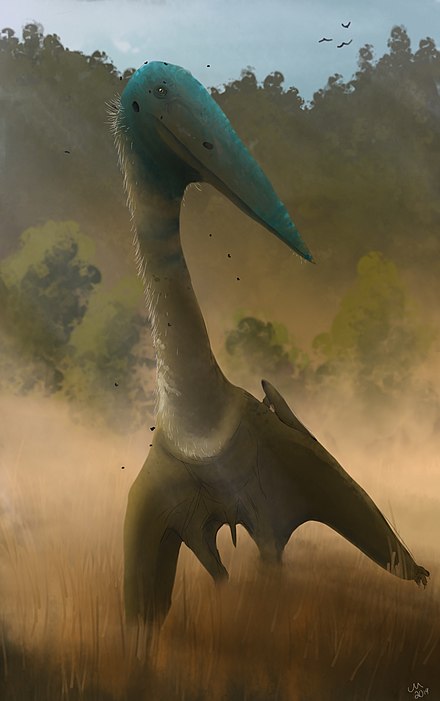Effigia okeeffeae, a shuvosaurid (an ancient relative of the crocodiles) that lived in North America during the Triassic period, was a specialist herbivore that likely fed on soft plant material, according to new research led by the University of Birmingham.
Life reconstruction of Effigia okeeffeae. Image credit: Mark Witton.
Effigia okeeffeae was about the size of a gazelle and lived in North America around 205 million years ago.
Its fossil remains were found in the Ghost Ranch Quarry in New Mexico in the 1940s, although the material was not formally described by paleontologists until 2006.
The remains had been relatively poorly preserved in the quarry and the skull, in particular, was quite badly deformed, making accurate reconstruction problematic.
Early analysis of the specimen concluded that it belonged to the group of reptiles that includes crocodylians and birds and which started to flourish in the Triassic period.
Although more closely related to crocodylians, Effigia okeeffeae’s lightweight body, elongated neck, large eyes and beak shared many similarities with a modern-day ostrich, leading paleontologists to believe the animal fed by pecking plant material from the ground.
But the new analysis revealed the Triassic animal was probably an entirely different type of herbivore than previously thought.
“Effigia okeeffeae exhibits an ‘ostrich-like’ bauplan comprising a gracile skeleton with edentulous jaws and large orbits, similar to ornithomimid dinosaurs and extant palaeognaths,” said lead author Dr. Jordan Bestwick from the School of Geography, Earth and Environmental Sciences at the University of Birmingham and colleagues.
“This bauplan is regarded as an adaptation for herbivory, but this hypothesis assumes morphological convergence confers functional convergence, and has received little explicit testing.”
In the study, the authors used new CT scans of Effigia okeeffeae’s skull which revealed a much more accurate reconstruction of the animal.
This included new information about the shape of the skull, such as a more rounded, bulbous brain cavity and curved upper and lower jaws.
Unlike an ostrich bill, which is more rounded, Effigia okeeffeae’s bill is more concave with jaws that open and close a bit like a pair of shears.
The researchers used this information to model the effects of different forces acting on the skull, including what happens when the animal pecks at the ground.
By modeling the forces the skull would need to withstand in order to feed by pecking, the scientists calculated that Effigia okeeffeae’s skull would probably have shattered.
Instead, they suggest, the animal would be more likely to use its jaws to snip off and nibble pieces of soft plant material such as young shoots, or ferns.
“The herbivores we already recognize in the Triassic period fed either by digging for roots, such as the pig-like aetosaurs, or reaching for leaves high up in the treetops, like the long-necked sauropods,” Dr. Bestwick said.
“These two-legged browsers with a weak bite are unique to this period and show a previously unrecognized diversity among the herbivores of this period.”
Source: sci.news









